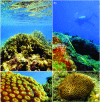Effects of depth on reef fish communities: Insights of a "deep refuge hypothesis" from Southwestern Atlantic reefs
- PMID: 30256788
- PMCID: PMC6157832
- DOI: 10.1371/journal.pone.0203072
Effects of depth on reef fish communities: Insights of a "deep refuge hypothesis" from Southwestern Atlantic reefs
Abstract
Deeper reefs are often considered to be less susceptible to local and global disturbances, such as overfishing, pollution and climate change, compared to shallow reefs and therefore could act as refugia for shallow water species. Hence, the interest on deeper reefs has happened at a time when shallow reefs are undergoing unprecedented changes. Here we investigated the hypothesis that fish community differed from shallow to deeper reefs due to factors apart from habitat structure and quality and therefore discuss for the first-time insights of a "deep refuge hypothesis" from Brazilian reefs. We collected data on fish community, benthic community and physiological conditions of two coral species on shallow (< 6 m) and deep reefs (> 25 m). No significant difference on substratum composition was observed comparing sites and depths. Additionally, physiological data on corals also showed similar oxidative status and growth conditions when comparing the two-coral species in shallow and deep reefs. Conversely, our study demonstrated strong differences on reef fish communities in terms of abundance, species richness, trophic groups, size classes and groups of interest when comparing shallow and deeper reefs. Fish abundance was 2-fold higher and species richness was up to 70% higher on deeper reefs. Also, a significant difference was observed comparing trophic groups of reef fish. Macrocarnivore, Mobile invertebrate feeders, Planktivores, Sessile Invertebrates Feeders and Roving Herbivores were more abundant on deeper reefs. On the other hand, Territorialist Herbivores almost exclusively dominated shallow reefs. Strong differences were also observed comparing the abundance of reef fish groups of interest and their respective size classes between shallow and deeper reefs. Ornamental, Great Herbivores and Groupers showed clear differences, with higher abundances being observed in deeper reefs. Considering size classes, larger individuals (> 15 cm) of Great Herbivores, Groupers and Snapper were uniquely recorded at deeper reefs. Additionally, individuals with > 30 cm were recorded almost exclusively on deeper reefs for all the analyzed groups of interest. Our findings suggest that fishing pressure on the target species may be attenuated on deeper reefs, and these regions may therefore be considered as areas of refuge from shallow water impacts. Therefore, the likely potential for deeper reefs protect species from natural or anthropogenic disturbances increases the attention of marine conservation planning and resource management on including deeper reefs in protected areas.
Conflict of interest statement
The authors have declared that no competing interests exist.
Figures








Similar articles
-
Conventional and technical diving surveys reveal elevated biomass and differing fish community composition from shallow and upper mesophotic zones of a remote United States coral reef.PLoS One. 2017 Nov 21;12(11):e0188598. doi: 10.1371/journal.pone.0188598. eCollection 2017. PLoS One. 2017. PMID: 29161314 Free PMC article.
-
The influence of fire-coral colony size and agonistic behaviour of territorial damselfish on associated coral reef fish communities.Mar Environ Res. 2015 Jul;108:45-54. doi: 10.1016/j.marenvres.2015.04.009. Epub 2015 Apr 27. Mar Environ Res. 2015. PMID: 25956544
-
Variability in the functional composition of coral reef fish communities on submerged and emergent reefs in the central Great Barrier Reef, Australia.PLoS One. 2019 May 17;14(5):e0216785. doi: 10.1371/journal.pone.0216785. eCollection 2019. PLoS One. 2019. PMID: 31100087 Free PMC article.
-
The ecology, behaviour and physiology of fishes on coral reef flats, and the potential impacts of climate change.J Fish Biol. 2013 Sep;83(3):417-47. doi: 10.1111/jfb.12203. J Fish Biol. 2013. PMID: 23991866 Review.
-
The flourishing and vulnerabilities of zoantharians on Southwestern Atlantic reefs.Mar Environ Res. 2022 Jan;173:105535. doi: 10.1016/j.marenvres.2021.105535. Epub 2021 Nov 24. Mar Environ Res. 2022. PMID: 34879290 Review.
Cited by
-
Deep reefs are not refugium for shallow-water fish communities in the southwestern Atlantic.Ecol Evol. 2021 Mar 18;11(9):4413-4427. doi: 10.1002/ece3.7336. eCollection 2021 May. Ecol Evol. 2021. PMID: 33976819 Free PMC article.
-
Protecting nursery areas without fisheries management is not enough to conserve the most endangered parrotfish of the Atlantic Ocean.Sci Rep. 2020 Nov 12;10(1):19143. doi: 10.1038/s41598-020-76207-x. Sci Rep. 2020. PMID: 33184332 Free PMC article.
-
Effectiveness of management zones for recovering parrotfish species within the largest coastal marine protected area in Brazil.Sci Rep. 2022 Jul 18;12(1):12232. doi: 10.1038/s41598-022-15990-1. Sci Rep. 2022. PMID: 35851599 Free PMC article.
-
Physiological Traits for Predicting Poleward Extensions in Tropical Fishes: From Lab to Management.Glob Chang Biol. 2025 Apr;31(4):e70213. doi: 10.1111/gcb.70213. Glob Chang Biol. 2025. PMID: 40290058 Free PMC article. Review.
-
Mediterranean nekton traits: distribution, relationships and significance for marine ecology monitoring and management.PeerJ. 2020 Feb 14;8:e8494. doi: 10.7717/peerj.8494. eCollection 2020. PeerJ. 2020. PMID: 32095343 Free PMC article.
References
-
- Moberg F, Folke C. Ecological goods and services of coral reef ecosystems. Ecological economics. 1999;29(2), 215–233
Publication types
MeSH terms
LinkOut - more resources
Full Text Sources
Other Literature Sources

